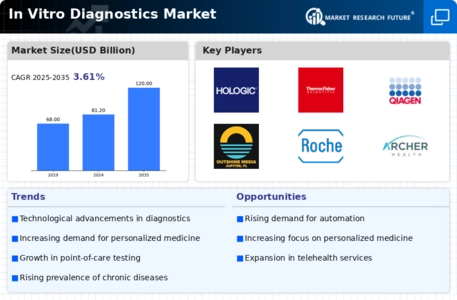Clinical Chemistry
Microbiology
Immunology
Molecular Diagnostics
Hematology
Reagents
Instruments
Software
Quality Control Products
Consumables
Hospitals
Diagnostic Laboratories
Academic and Research Institutions
Home Care Settings
Infectious Diseases
Diabetes
Oncology
Cardiovascular Diseases
Genetic Testing
North America
Europe
South America
Asia Pacific
Middle East and Africa
North America Outlook (USD Billion, 2019-2035)
North America In Vitro Diagnostics Market by Test Type
Clinical Chemistry
Microbiology
Immunology
Molecular Diagnostics
Hematology
North America In Vitro Diagnostics Market by Product Type
Reagents
Instruments
Software
Quality Control Products
Consumables
North America In Vitro Diagnostics Market by End User Type
Hospitals
Diagnostic Laboratories
Academic and Research Institutions
Home Care Settings
North America In Vitro Diagnostics Market by Application Type
Infectious Diseases
Diabetes
Oncology
Cardiovascular Diseases
Genetic Testing
North America In Vitro Diagnostics Market by Regional Type
US
Canada
US Outlook (USD Billion, 2019-2035)
US In Vitro Diagnostics Market by Test Type
Clinical Chemistry
Microbiology
Immunology
Molecular Diagnostics
Hematology
US In Vitro Diagnostics Market by Product Type
Reagents
Instruments
Software
Quality Control Products
Consumables
US In Vitro Diagnostics Market by End User Type
Hospitals
Diagnostic Laboratories
Academic and Research Institutions
Home Care Settings
US In Vitro Diagnostics Market by Application Type
Infectious Diseases
Diabetes
Oncology
Cardiovascular Diseases
Genetic Testing
CANADA Outlook (USD Billion, 2019-2035)
CANADA In Vitro Diagnostics Market by Test Type
Clinical Chemistry
Microbiology
Immunology
Molecular Diagnostics
Hematology
CANADA In Vitro Diagnostics Market by Product Type
Reagents
Instruments
Software
Quality Control Products
Consumables
CANADA In Vitro Diagnostics Market by End User Type
Hospitals
Diagnostic Laboratories
Academic and Research Institutions
Home Care Settings
CANADA In Vitro Diagnostics Market by Application Type
Infectious Diseases
Diabetes
Oncology
Cardiovascular Diseases
Genetic Testing
Europe Outlook (USD Billion, 2019-2035)
Europe In Vitro Diagnostics Market by Test Type
Clinical Chemistry
Microbiology
Immunology
Molecular Diagnostics
Hematology
Europe In Vitro Diagnostics Market by Product Type
Reagents
Instruments
Software
Quality Control Products
Consumables
Europe In Vitro Diagnostics Market by End User Type
Hospitals
Diagnostic Laboratories
Academic and Research Institutions
Home Care Settings
Europe In Vitro Diagnostics Market by Application Type
Infectious Diseases
Diabetes
Oncology
Cardiovascular Diseases
Genetic Testing
Europe In Vitro Diagnostics Market by Regional Type
Germany
UK
France
Russia
Italy
Spain
Rest of Europe
GERMANY Outlook (USD Billion, 2019-2035)
GERMANY In Vitro Diagnostics Market by Test Type
Clinical Chemistry
Microbiology
Immunology
Molecular Diagnostics
Hematology
GERMANY In Vitro Diagnostics Market by Product Type
Reagents
Instruments
Software
Quality Control Products
Consumables
GERMANY In Vitro Diagnostics Market by End User Type
Hospitals
Diagnostic Laboratories
Academic and Research Institutions
Home Care Settings
GERMANY In Vitro Diagnostics Market by Application Type
Infectious Diseases
Diabetes
Oncology
Cardiovascular Diseases
Genetic Testing
UK Outlook (USD Billion, 2019-2035)
UK In Vitro Diagnostics Market by Test Type
Clinical Chemistry
Microbiology
Immunology
Molecular Diagnostics
Hematology
UK In Vitro Diagnostics Market by Product Type
Reagents
Instruments
Software
Quality Control Products
Consumables
UK In Vitro Diagnostics Market by End User Type
Hospitals
Diagnostic Laboratories
Academic and Research Institutions
Home Care Settings
UK In Vitro Diagnostics Market by Application Type
Infectious Diseases
Diabetes
Oncology
Cardiovascular Diseases
Genetic Testing
FRANCE Outlook (USD Billion, 2019-2035)
FRANCE In Vitro Diagnostics Market by Test Type
Clinical Chemistry
Microbiology
Immunology
Molecular Diagnostics
Hematology
FRANCE In Vitro Diagnostics Market by Product Type
Reagents
Instruments
Software
Quality Control Products
Consumables
FRANCE In Vitro Diagnostics Market by End User Type
Hospitals
Diagnostic Laboratories
Academic and Research Institutions
Home Care Settings
FRANCE In Vitro Diagnostics Market by Application Type
Infectious Diseases
Diabetes
Oncology
Cardiovascular Diseases
Genetic Testing
RUSSIA Outlook (USD Billion, 2019-2035)
RUSSIA In Vitro Diagnostics Market by Test Type
Clinical Chemistry
Microbiology
Immunology
Molecular Diagnostics
Hematology
RUSSIA In Vitro Diagnostics Market by Product Type
Reagents
Instruments
Software
Quality Control Products
Consumables
RUSSIA In Vitro Diagnostics Market by End User Type
Hospitals
Diagnostic Laboratories
Academic and Research Institutions
Home Care Settings
RUSSIA In Vitro Diagnostics Market by Application Type
Infectious Diseases
Diabetes
Oncology
Cardiovascular Diseases
Genetic Testing
ITALY Outlook (USD Billion, 2019-2035)
ITALY In Vitro Diagnostics Market by Test Type
Clinical Chemistry
Microbiology
Immunology
Molecular Diagnostics
Hematology
ITALY In Vitro Diagnostics Market by Product Type
Reagents
Instruments
Software
Quality Control Products
Consumables
ITALY In Vitro Diagnostics Market by End User Type
Hospitals
Diagnostic Laboratories
Academic and Research Institutions
Home Care Settings
ITALY In Vitro Diagnostics Market by Application Type
Infectious Diseases
Diabetes
Oncology
Cardiovascular Diseases
Genetic Testing
SPAIN Outlook (USD Billion, 2019-2035)
SPAIN In Vitro Diagnostics Market by Test Type
Clinical Chemistry
Microbiology
Immunology
Molecular Diagnostics
Hematology
SPAIN In Vitro Diagnostics Market by Product Type
Reagents
Instruments
Software
Quality Control Products
Consumables
SPAIN In Vitro Diagnostics Market by End User Type
Hospitals
Diagnostic Laboratories
Academic and Research Institutions
Home Care Settings
SPAIN In Vitro Diagnostics Market by Application Type
Infectious Diseases
Diabetes
Oncology
Cardiovascular Diseases
Genetic Testing
REST OF EUROPE Outlook (USD Billion, 2019-2035)
REST OF EUROPE In Vitro Diagnostics Market by Test Type
Clinical Chemistry
Microbiology
Immunology
Molecular Diagnostics
Hematology
REST OF EUROPE In Vitro Diagnostics Market by Product Type
Reagents
Instruments
Software
Quality Control Products
Consumables
REST OF EUROPE In Vitro Diagnostics Market by End User Type
Hospitals
Diagnostic Laboratories
Academic and Research Institutions
Home Care Settings
REST OF EUROPE In Vitro Diagnostics Market by Application Type
Infectious Diseases
Diabetes
Oncology
Cardiovascular Diseases
Genetic Testing
APAC Outlook (USD Billion, 2019-2035)
APAC In Vitro Diagnostics Market by Test Type
Clinical Chemistry
Microbiology
Immunology
Molecular Diagnostics
Hematology
APAC In Vitro Diagnostics Market by Product Type
Reagents
Instruments
Software
Quality Control Products
Consumables
APAC In Vitro Diagnostics Market by End User Type
Hospitals
Diagnostic Laboratories
Academic and Research Institutions
Home Care Settings
APAC In Vitro Diagnostics Market by Application Type
Infectious Diseases
Diabetes
Oncology
Cardiovascular Diseases
Genetic Testing
APAC In Vitro Diagnostics Market by Regional Type
China
India
Japan
South Korea
Malaysia
Thailand
Indonesia
Rest of APAC
CHINA Outlook (USD Billion, 2019-2035)
CHINA In Vitro Diagnostics Market by Test Type
Clinical Chemistry
Microbiology
Immunology
Molecular Diagnostics
Hematology
CHINA In Vitro Diagnostics Market by Product Type
Reagents
Instruments
Software
Quality Control Products
Consumables
CHINA In Vitro Diagnostics Market by End User Type
Hospitals
Diagnostic Laboratories
Academic and Research Institutions
Home Care Settings
CHINA In Vitro Diagnostics Market by Application Type
Infectious Diseases
Diabetes
Oncology
Cardiovascular Diseases
Genetic Testing
INDIA Outlook (USD Billion, 2019-2035)
INDIA In Vitro Diagnostics Market by Test Type
Clinical Chemistry
Microbiology
Immunology
Molecular Diagnostics
Hematology
INDIA In Vitro Diagnostics Market by Product Type
Reagents
Instruments
Software
Quality Control Products
Consumables
INDIA In Vitro Diagnostics Market by End User Type
Hospitals
Diagnostic Laboratories
Academic and Research Institutions
Home Care Settings
INDIA In Vitro Diagnostics Market by Application Type
Infectious Diseases
Diabetes
Oncology
Cardiovascular Diseases
Genetic Testing
JAPAN Outlook (USD Billion, 2019-2035)
JAPAN In Vitro Diagnostics Market by Test Type
Clinical Chemistry
Microbiology
Immunology
Molecular Diagnostics
Hematology
JAPAN In Vitro Diagnostics Market by Product Type
Reagents
Instruments
Software
Quality Control Products
Consumables
JAPAN In Vitro Diagnostics Market by End User Type
Hospitals
Diagnostic Laboratories
Academic and Research Institutions
Home Care Settings
JAPAN In Vitro Diagnostics Market by Application Type
Infectious Diseases
Diabetes
Oncology
Cardiovascular Diseases
Genetic Testing
SOUTH KOREA Outlook (USD Billion, 2019-2035)
SOUTH KOREA In Vitro Diagnostics Market by Test Type
Clinical Chemistry
Microbiology
Immunology
Molecular Diagnostics
Hematology
SOUTH KOREA In Vitro Diagnostics Market by Product Type
Reagents
Instruments
Software
Quality Control Products
Consumables
SOUTH KOREA In Vitro Diagnostics Market by End User Type
Hospitals
Diagnostic Laboratories
Academic and Research Institutions
Home Care Settings
SOUTH KOREA In Vitro Diagnostics Market by Application Type
Infectious Diseases
Diabetes
Oncology
Cardiovascular Diseases
Genetic Testing
MALAYSIA Outlook (USD Billion, 2019-2035)
MALAYSIA In Vitro Diagnostics Market by Test Type
Clinical Chemistry
Microbiology
Immunology
Molecular Diagnostics
Hematology
MALAYSIA In Vitro Diagnostics Market by Product Type
Reagents
Instruments
Software
Quality Control Products
Consumables
MALAYSIA In Vitro Diagnostics Market by End User Type
Hospitals
Diagnostic Laboratories
Academic and Research Institutions
Home Care Settings
MALAYSIA In Vitro Diagnostics Market by Application Type
Infectious Diseases
Diabetes
Oncology
Cardiovascular Diseases
Genetic Testing
THAILAND Outlook (USD Billion, 2019-2035)
THAILAND In Vitro Diagnostics Market by Test Type
Clinical Chemistry
Microbiology
Immunology
Molecular Diagnostics
Hematology
THAILAND In Vitro Diagnostics Market by Product Type
Reagents
Instruments
Software
Quality Control Products
Consumables
THAILAND In Vitro Diagnostics Market by End User Type
Hospitals
Diagnostic Laboratories
Academic and Research Institutions
Home Care Settings
THAILAND In Vitro Diagnostics Market by Application Type
Infectious Diseases
Diabetes
Oncology
Cardiovascular Diseases
Genetic Testing
INDONESIA Outlook (USD Billion, 2019-2035)
INDONESIA In Vitro Diagnostics Market by Test Type
Clinical Chemistry
Microbiology
Immunology
Molecular Diagnostics
Hematology
INDONESIA In Vitro Diagnostics Market by Product Type
Reagents
Instruments
Software
Quality Control Products
Consumables
INDONESIA In Vitro Diagnostics Market by End User Type
Hospitals
Diagnostic Laboratories
Academic and Research Institutions
Home Care Settings
INDONESIA In Vitro Diagnostics Market by Application Type
Infectious Diseases
Diabetes
Oncology
Cardiovascular Diseases
Genetic Testing
REST OF APAC Outlook (USD Billion, 2019-2035)
REST OF APAC In Vitro Diagnostics Market by Test Type
Clinical Chemistry
Microbiology
Immunology
Molecular Diagnostics
Hematology
REST OF APAC In Vitro Diagnostics Market by Product Type
Reagents
Instruments
Software
Quality Control Products
Consumables
REST OF APAC In Vitro Diagnostics Market by End User Type
Hospitals
Diagnostic Laboratories
Academic and Research Institutions
Home Care Settings
REST OF APAC In Vitro Diagnostics Market by Application Type
Infectious Diseases
Diabetes
Oncology
Cardiovascular Diseases
Genetic Testing
South America Outlook (USD Billion, 2019-2035)
South America In Vitro Diagnostics Market by Test Type
Clinical Chemistry
Microbiology
Immunology
Molecular Diagnostics
Hematology
South America In Vitro Diagnostics Market by Product Type
Reagents
Instruments
Software
Quality Control Products
Consumables
South America In Vitro Diagnostics Market by End User Type
Hospitals
Diagnostic Laboratories
Academic and Research Institutions
Home Care Settings
South America In Vitro Diagnostics Market by Application Type
Infectious Diseases
Diabetes
Oncology
Cardiovascular Diseases
Genetic Testing
South America In Vitro Diagnostics Market by Regional Type
Brazil
Mexico
Argentina
Rest of South America
BRAZIL Outlook (USD Billion, 2019-2035)
BRAZIL In Vitro Diagnostics Market by Test Type
Clinical Chemistry
Microbiology
Immunology
Molecular Diagnostics
Hematology
BRAZIL In Vitro Diagnostics Market by Product Type
Reagents
Instruments
Software
Quality Control Products
Consumables
BRAZIL In Vitro Diagnostics Market by End User Type
Hospitals
Diagnostic Laboratories
Academic and Research Institutions
Home Care Settings
BRAZIL In Vitro Diagnostics Market by Application Type
Infectious Diseases
Diabetes
Oncology
Cardiovascular Diseases
Genetic Testing
MEXICO Outlook (USD Billion, 2019-2035)
MEXICO In Vitro Diagnostics Market by Test Type
Clinical Chemistry
Microbiology
Immunology
Molecular Diagnostics
Hematology
MEXICO In Vitro Diagnostics Market by Product Type
Reagents
Instruments
Software
Quality Control Products
Consumables
MEXICO In Vitro Diagnostics Market by End User Type
Hospitals
Diagnostic Laboratories
Academic and Research Institutions
Home Care Settings
MEXICO In Vitro Diagnostics Market by Application Type
Infectious Diseases
Diabetes
Oncology
Cardiovascular Diseases
Genetic Testing
ARGENTINA Outlook (USD Billion, 2019-2035)
ARGENTINA In Vitro Diagnostics Market by Test Type
Clinical Chemistry
Microbiology
Immunology
Molecular Diagnostics
Hematology
ARGENTINA In Vitro Diagnostics Market by Product Type
Reagents
Instruments
Software
Quality Control Products
Consumables
ARGENTINA In Vitro Diagnostics Market by End User Type
Hospitals
Diagnostic Laboratories
Academic and Research Institutions
Home Care Settings
ARGENTINA In Vitro Diagnostics Market by Application Type
Infectious Diseases
Diabetes
Oncology
Cardiovascular Diseases
Genetic Testing
REST OF SOUTH AMERICA Outlook (USD Billion, 2019-2035)
REST OF SOUTH AMERICA In Vitro Diagnostics Market by Test Type
Clinical Chemistry
Microbiology
Immunology
Molecular Diagnostics
Hematology
REST OF SOUTH AMERICA In Vitro Diagnostics Market by Product Type
Reagents
Instruments
Software
Quality Control Products
Consumables
REST OF SOUTH AMERICA In Vitro Diagnostics Market by End User Type
Hospitals
Diagnostic Laboratories
Academic and Research Institutions
Home Care Settings
REST OF SOUTH AMERICA In Vitro Diagnostics Market by Application Type
Infectious Diseases
Diabetes
Oncology
Cardiovascular Diseases
Genetic Testing
MEA Outlook (USD Billion, 2019-2035)
MEA In Vitro Diagnostics Market by Test Type
Clinical Chemistry
Microbiology
Immunology
Molecular Diagnostics
Hematology
MEA In Vitro Diagnostics Market by Product Type
Reagents
Instruments
Software
Quality Control Products
Consumables
MEA In Vitro Diagnostics Market by End User Type
Hospitals
Diagnostic Laboratories
Academic and Research Institutions
Home Care Settings
MEA In Vitro Diagnostics Market by Application Type
Infectious Diseases
Diabetes
Oncology
Cardiovascular Diseases
Genetic Testing
MEA In Vitro Diagnostics Market by Regional Type
GCC Countries
South Africa
Rest of MEA
GCC COUNTRIES Outlook (USD Billion, 2019-2035)
GCC COUNTRIES In Vitro Diagnostics Market by Test Type
Clinical Chemistry
Microbiology
Immunology
Molecular Diagnostics
Hematology
GCC COUNTRIES In Vitro Diagnostics Market by Product Type
Reagents
Instruments
Software
Quality Control Products
Consumables
GCC COUNTRIES In Vitro Diagnostics Market by End User Type
Hospitals
Diagnostic Laboratories
Academic and Research Institutions
Home Care Settings
GCC COUNTRIES In Vitro Diagnostics Market by Application Type
Infectious Diseases
Diabetes
Oncology
Cardiovascular Diseases
Genetic Testing
SOUTH AFRICA Outlook (USD Billion, 2019-2035)
SOUTH AFRICA In Vitro Diagnostics Market by Test Type
Clinical Chemistry
Microbiology
Immunology
Molecular Diagnostics
Hematology
SOUTH AFRICA In Vitro Diagnostics Market by Product Type
Reagents
Instruments
Software
Quality Control Products
Consumables
SOUTH AFRICA In Vitro Diagnostics Market by End User Type
Hospitals
Diagnostic Laboratories
Academic and Research Institutions
Home Care Settings
SOUTH AFRICA In Vitro Diagnostics Market by Application Type
Infectious Diseases
Diabetes
Oncology
Cardiovascular Diseases
Genetic Testing
REST OF MEA Outlook (USD Billion, 2019-2035)
REST OF MEA In Vitro Diagnostics Market by Test Type
Clinical Chemistry
Microbiology
Immunology
Molecular Diagnostics
Hematology
REST OF MEA In Vitro Diagnostics Market by Product Type
Reagents
Instruments
Software
Quality Control Products
Consumables
REST OF MEA In Vitro Diagnostics Market by End User Type
Hospitals
Diagnostic Laboratories
Academic and Research Institutions
Home Care Settings
REST OF MEA In Vitro Diagnostics Market by Application Type
Infectious Diseases
Diabetes
Oncology
Cardiovascular Diseases
Genetic Testing

















Leave a Comment